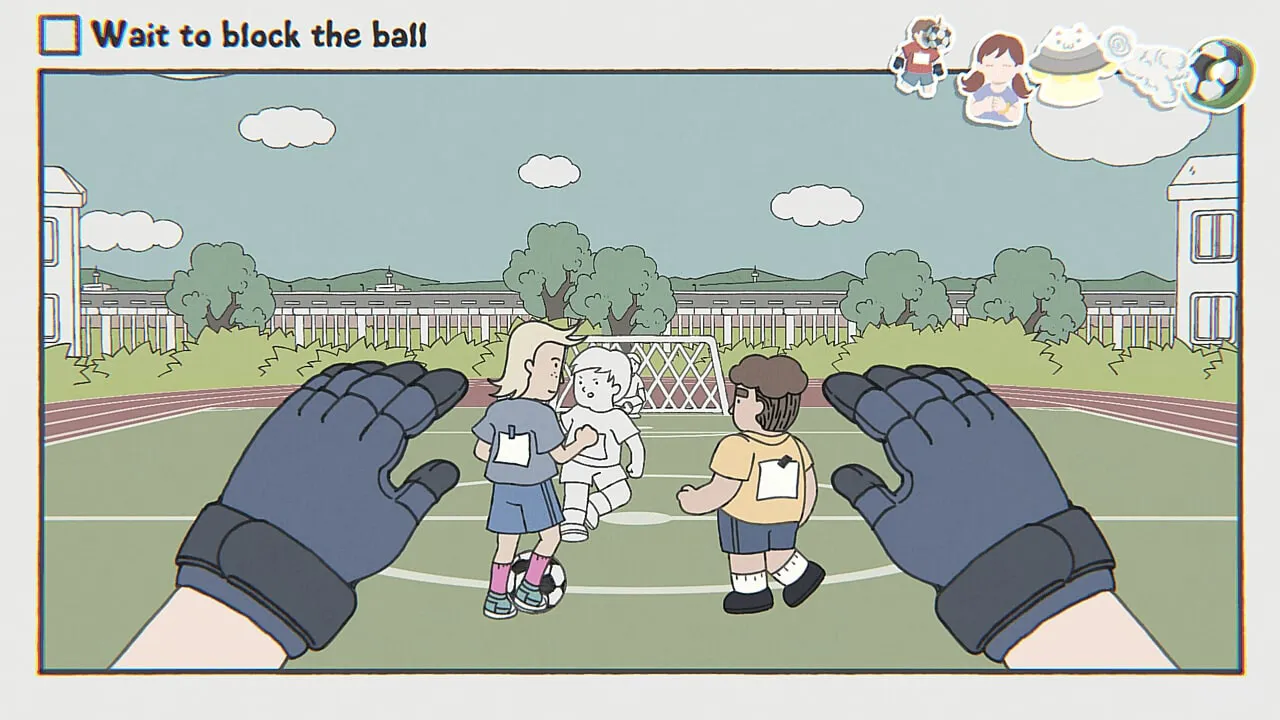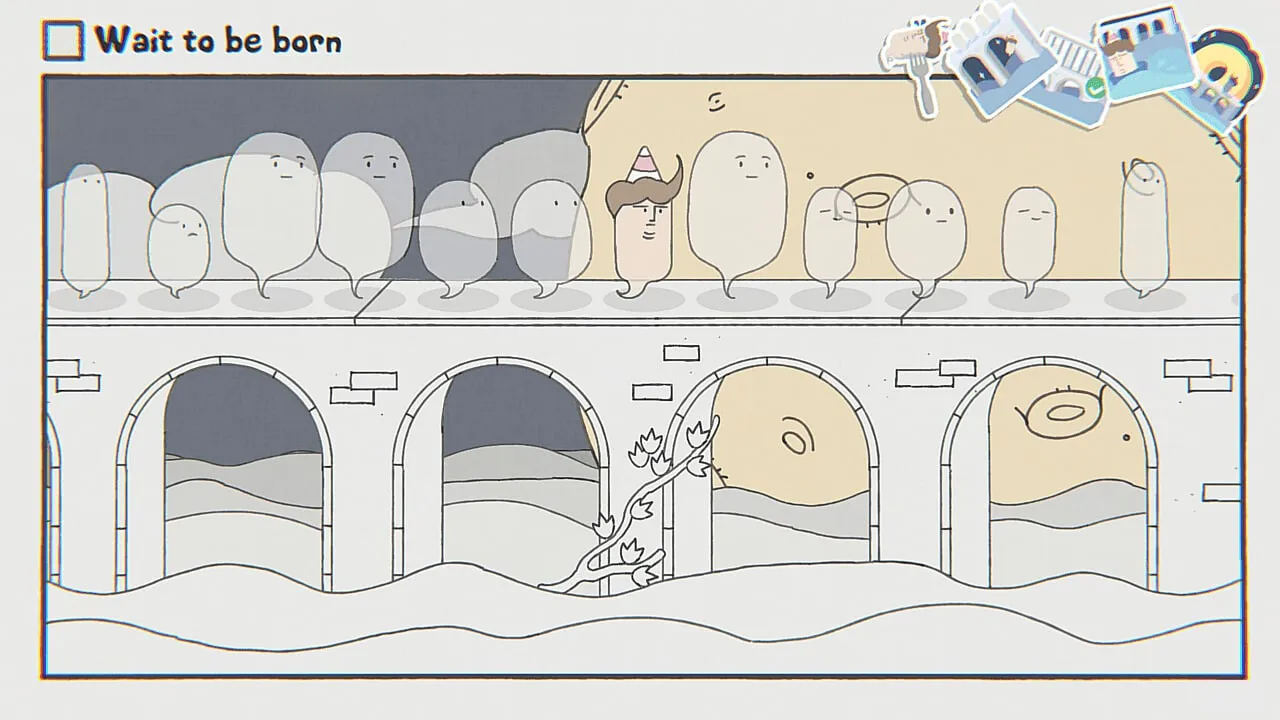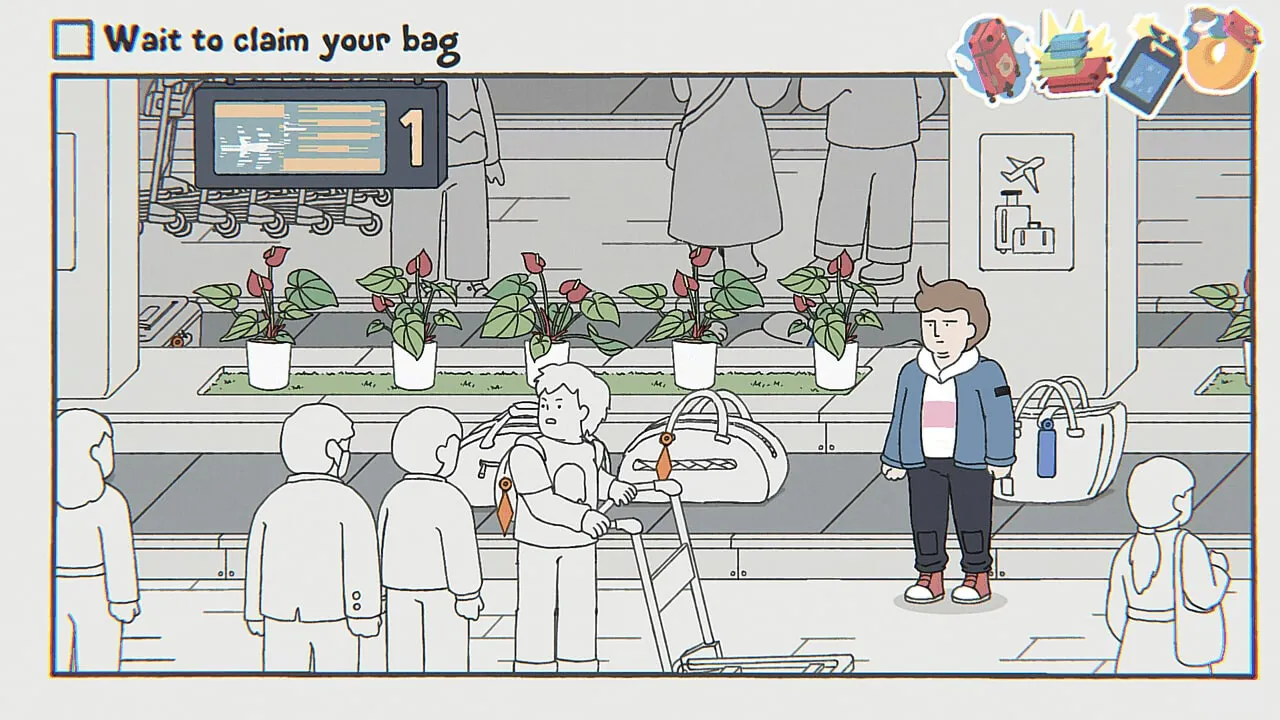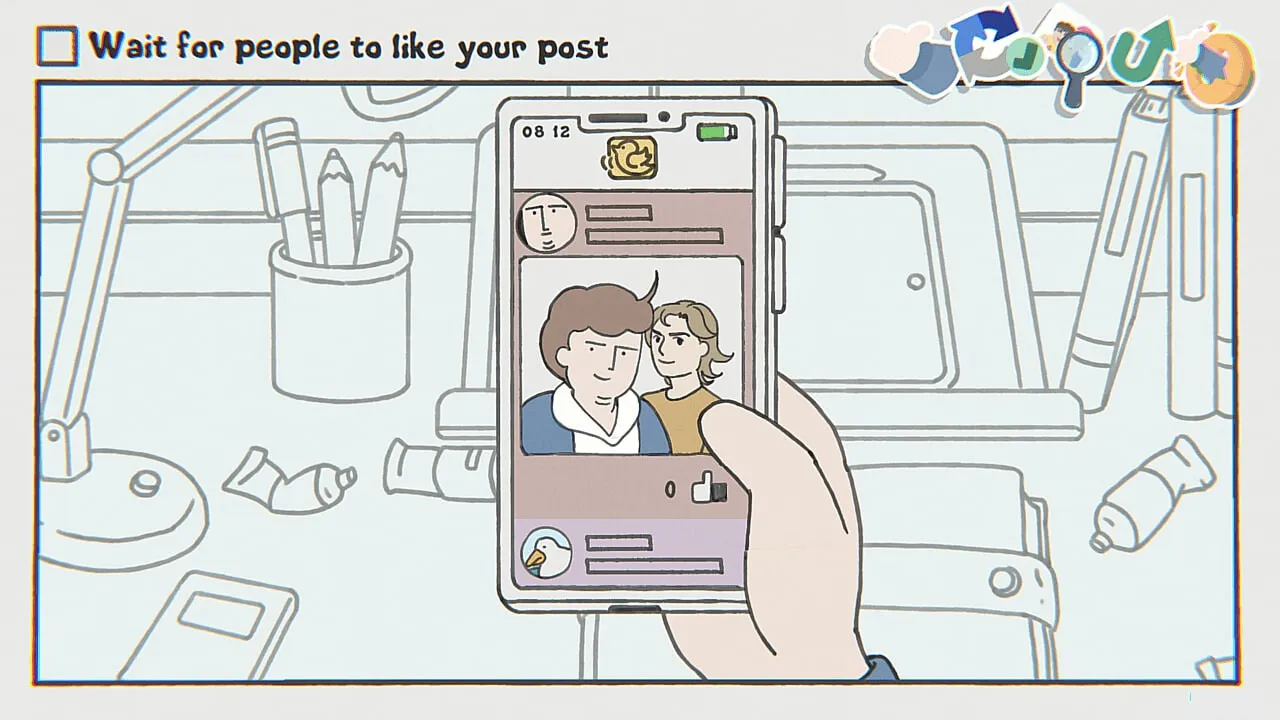In While Waiting, the concept of pausing is transformed into a canvas that reflects everyday human life. The game invites players to observe the unfolding of familiar scenes as a small character evolves from a playful child into an adult encountering life’s common challenges.
Moments such as a child trying to snag shrimp tempura or an office worker sidestepping a monotonous meeting are set against a backdrop that draws on traditions and everyday routines observed around the world.
The mechanics allow for both quiet observation and direct intervention. Players can choose to let scenes progress on their own or interact with the environment in unexpected ways. This balance encourages an examination of how different cultures regard time, routine, and the small acts of rebellion against monotony.
The environments, whether depicting a modest home setting or a crowded public space, are rendered in a style reminiscent of comic panels, offering a familiar yet fresh visual interpretation of daily life.
The narrative structure employs simple, evocative scenes that recall techniques found in international visual storytelling and local folklore. Each vignette serves as a reflection of shared human experiences, prompting thoughts on how cultural traditions shape the perception of ordinary moments without providing a single, definitive perspective.
Cross-Cultural Play: The Mechanics of Waiting
In While Waiting, the passage of time serves as the engine for each scenario. The game employs a point-and-click interface that guides the character through a series of timed episodes, where choices unfold alongside a steadily advancing clock.
This method of interaction pairs with everyday moments that echo experiences found across different cultures—from patiently anticipating a meal to subtly altering routine actions. Players face the decision to engage directly with each scene or to observe events as they naturally progress, a design that mirrors storytelling traditions that value silence and deliberate pacing.
The game offers a range of optional challenges that extend beyond basic interaction. Simple tasks, such as adjusting the volume on a television, sit alongside more complex puzzles that require careful observation and timing. This array of choices empowers players to tailor their experience, switching between deliberate intervention and a watchful waiting approach that mirrors various cultural attitudes toward time and agency.
The control scheme centers on the intuitive point-and-click method, which aligns with the measured pace of the gameplay. An alternative setup featuring keyboard inputs—specifically the WASD keys and the space bar—is also available.
This option can occasionally feel less precise during moments that demand exact timing. These choices in interaction invite comparisons with other interactive works that reflect diverse cultural practices, prompting reflection on how local traditions and artistic methods influence design decisions in interactive media.
Chronicling Life’s Moments: Narrative and Storytelling
While Waiting organizes life into brief segments that capture the essence of human experience through pauses in time. The narrative follows a single character as they progress from early playful antics to the more measured experiences of later years.
Early scenes present a child engaged in mischievous acts—snatching a stray shrimp tempura or peeking into unexpected corners of their environment—while later moments reflect the more complicated routines of adult existence. Each vignette isolates a distinct episode of waiting, rendering it as both a personal memory and a shared human condition.
The game employs a minimalist style that relies on visual cues and a sparing use of text. Scenes unfold with the clarity of a well-composed image, offering players just enough detail to spark personal interpretation.
Humorous touches intersperse with quieter passages, allowing the imagery to communicate subtle observations about daily life. This style evokes techniques seen in international cinema, where silence and visual economy carry significant weight, prompting comparisons to visual narratives found in global art forms.
Player choices further shape the unfolding narrative. The character’s decisions—whether to actively interfere or to allow moments to pass undisturbed—are integral to their evolving persona. The playful defiance of childhood gradually yields to a more thoughtful engagement with routine and responsibility. This interplay of action and restraint highlights how personal agency can alter the perception of mundane moments.
Such freedom encourages a reflection on the influence of diverse cultural practices and societal expectations on behavior. The structure of each scene prompts an ongoing inquiry into how everyday pauses can serve as mirrors of our collective experiences, inviting an open examination of the interplay between individual impulses and established norms.
Mosaic of Moments: Level Design and Replayability Across Cultures
The game organizes its content into one hundred brief segments, each spanning only a few minutes while marking a specific chapter in the protagonist’s evolving life.
Every segment is carefully crafted to mirror culturally familiar routines—such as patiently waiting for a meal or enduring a sluggish commute—offering a window into everyday practices that resonate across diverse societies. These scenarios evoke images of community gatherings and traditional rituals, prompting players to reconsider the everyday in a new light.
Optional challenges further expand on this design by introducing extra tasks like collecting stickers or solving concise puzzles. Such features encourage repeated playthroughs and inspire players to alter the natural flow of a scene.
A player might choose to let the moment unfold in its intended form, or actively stir the calm with a surprising twist—each choice serving as a subtle commentary on personal decision-making within a socially prescribed framework. For instance, a deliberate act of disruption during a quiet waiting period transforms the scenario into an unexpected exploration of spontaneity and conformity.
This interplay between structured levels and open-ended challenges creates a dynamic where small actions shift the rhythm of the experience. The design prompts an ongoing conversation about daily rituals, urging players to examine how fleeting decisions can reconfigure a familiar scene. The game invites questions about the nature of routine and the impact of individual choice, leaving a space for contemplation without prescribing a definitive interpretation.
Artistic Synthesis: Visual and Audio Design in While Waiting
The game presents a striking visual narrative through a style reminiscent of classic comic strips. The layout divides each scenario into separate panels that recall the aesthetics of graphic novels found in various parts of the world.
Colors chosen are bold and expressive, while the characters appear with minimal detail, evoking an art tradition that prizes simplicity and clarity. This design choice invites players to experience familiar moments with a fresh perspective, drawing subtle connections to artistic practices from different cultural origins.
The auditory experience is shaped by orchestral scores and classical compositions that lend a refined atmosphere to the game. Sound effects punctuate the scenes at key moments, whether they underscore a quiet joke in a home setting or add a hint of suspense during a thoughtful pause. In one level, the delicate interplay of soft musical chords and the ambient murmur of a busy street creates an immersive setting that mirrors techniques seen in international visual narratives.
Art and sound are intertwined throughout each scene, with the measured pace of the visuals enhanced by carefully layered audio. In several instances, a character’s idle wait in an everyday setting is accompanied by subtle musical cues that heighten the mood and invite reflection.
This integration suggests that even routine moments can carry distinct artistic significance, opening up a dialogue between visual simplicity and musical sophistication without prescribing a single interpretation.
Digital Craftsmanship: Technical Performance and User Experience
The game presents a user interface crafted with clarity and care. The main menu and on-screen indicators reflect a design style familiar to players across various regions.
Navigation elements are arranged in a straightforward manner that minimizes the learning curve, offering a clean and efficient layout. This simplicity echoes design practices seen in interactive works from different cultural traditions, where ease of use and visual clarity are prized.
Technical irregularities occur intermittently, with minor glitches or brief stutters appearing during gameplay. Given that each level occupies only a few minutes, these issues tend not to overwhelm the overall experience.
The short duration of each segment helps maintain engagement, as any disruption is quickly bypassed by the next scenario. Such a design choice parallels approaches in other interactive media, where transient technical hiccups rarely compromise the intended experience.
The control system provides a dual option: a point-and-click interface complemented by keyboard inputs. The mouse-driven setup offers intuitive operation for those unfamiliar with more precise controls, while the keyboard configuration challenges players seeking tighter responsiveness.
Refinements in control sensitivity could further enhance the experience, drawing from international design principles that prioritize smooth and responsive interaction.
Reflections on Time and Silence
The game transforms moments of waiting into opportunities for quiet observation. Rather than demanding constant action, it invites players to pause and witness the slow passage of time as the character experiences life in its many stages.
Early scenes capture the lighthearted mischief of youth—small acts of defiance and playful curiosity—while later segments show a more measured response to everyday delays. This approach reflects a sensitivity found in art forms from diverse regions, where silence is seen as a space for personal reflection and quiet revelation.
Emotional expression in the game shifts gently from playful humor to touches of poignant introspection. A brief, mischievous encounter may quickly give way to a scene filled with tender nostalgia, prompting memories of one’s own moments spent waiting.
Visual cues, sparse dialogue, and subtle narrative hints work together much like the quiet sequences in certain international films, leaving much of the meaning open for personal interpretation. In this way, each vignette invites the player to connect personal experiences with a broader, global sense of time and human emotion.
The option to remain inactive during key moments challenges the notion that constant engagement is necessary. This choice raises questions about control and the true value of intervention.
By allowing inaction, the game comments on the modern impulse to fill every pause with distraction, suggesting instead that silence can offer a rich canvas for thought. This quiet tension between doing and not doing sparks reflections on fate, free will, and the nature of progress—a conversation that finds echoes in contemporary cultural discussions across various artistic traditions.
The Review
While Waiting
While Waiting offers a clever mix of playful interactions and quiet moments that mirror diverse cultural practices. Its simple visuals and clear audio design create a pleasing atmosphere, while the game’s structure invites thoughtful choices about engagement. The narrative and mechanics combine to capture everyday life in a way that prompts reflection, even as minor technical issues surface.
PROS
- Engaging narrative that turns ordinary pauses into reflective experiences
- Charming, minimalist visuals with a comic-inspired layout
- Flexible gameplay offering both active participation and quiet observation
- Culturally resonant themes that invite personal reflection
CONS
- Occasional technical glitches that interrupt immersion
- Control scheme may feel unresponsive in critical moments
- Optional challenges can seem repetitive
- Limited narrative depth in certain segments





















































